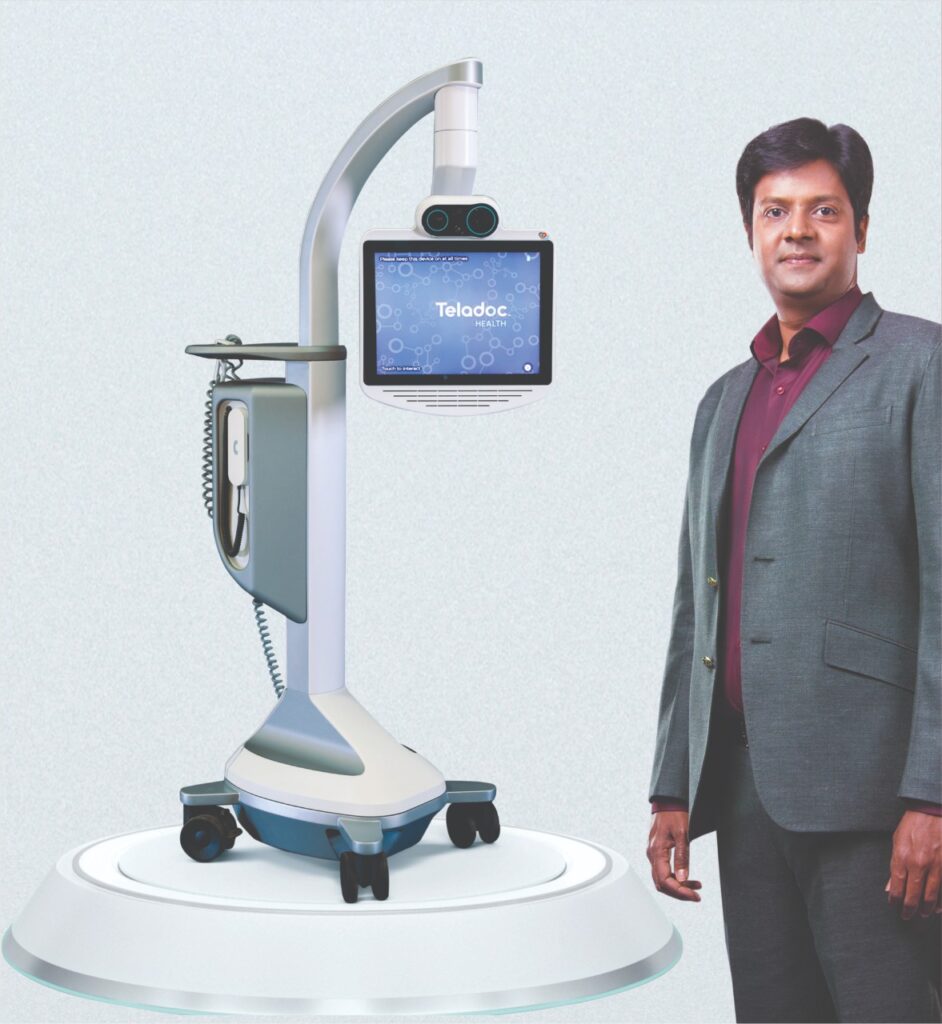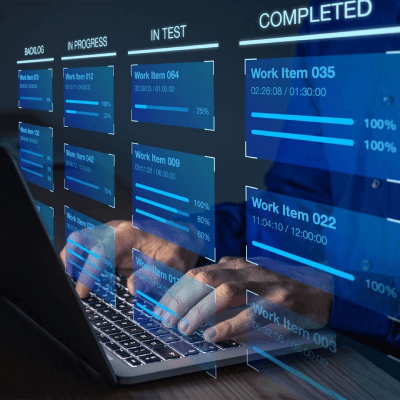- Meenakshi Mission Hospital is the first healthcare institution in India to deploy advanced telehealth technology. It acquired 16 Teladoc Health Vita robots last year in August when the pandemic was raging and close contact between doctor and patient was not advisable.
- The technology helped curb the spread of Covid infection by enabling remote diagnosis and monitoring of patient parameter. They acted as force-multipliers for the hospital which had 250 dedicated Covid beds but the number of doctors who could treat them was limited.
MADURAI / November 9, 2021: India’s largest and only installation of advanced virtual care at Meenakshi Mission Hospital & Research Centre (MMHRC) in Madurai proved to be a gamechanger in Covid times by remotely connecting more than 40,000 patients, including both outpatients and inpatients, to doctors for treatment in the thick of the pandemic, significantly helping curb the spread of Coronavirus infection and improving health outcomes.
This is the first time that a hospital in India has deployed state-of-the-art virtual care robots that are being used in six of the world’s top ten hospitals.

Important Announcement – EasyShiksha has now started Online Internship Program “Ab India Sikhega Ghar Se”

MMHRC acquired 16 self-driving robots from the US-based Teladoc Health, the global leader in whole-person virtual care in August last year to enable doctors to provide virtual care to patients when the Covid pandemic was raging. Said Dr. S Gurushankar, Chairman of the 1,000-bed Meenakshi Mission Hospital & Research Centre at Madurai: “We decided to deploy Teladoc Health technology to enhance the diagnostic abilities of doctors and connect them with patients remotely. These devices empowered our doctors to treat patients anywhere, anytime by acting as their third eye, through which they could remotely access all parameters of patients. Since August last year, over 40,000 inpatients and outpatients have been treated at our hospital during and after the second wave of Covid using these robots. Over 3,500 of these were Covid-positive patients admitted to the Covid, ICU, and Emergency wards at our hospital. We managed to prevent thousands of potential cases of Coronavirus infection which may have occurred had there been face-to-face contact between patients and doctors in the critical months when the pandemic was at its peak. This helped save lives and reduce the burden on the healthcare infrastructure.”

Dr. S Gurushankar added: “These robots can collect and process data from other diagnostic equipment and present it to doctors to help them make clinical decisions. They enable as many as six specialists to come together remotely at the same time to treat and monitor a patient suffering from multiple complications. Specialists can cross-consult each other regarding a patient, and even consult remotely with doctors located in other countries like the US and the UK. At our hospital, we have integrated these robots with our USG, ECHO, Cathlab, and other diagnostic devices to monitor patient parameters. They are also connected with our Picture Archiving and Communication System (PACS) through which doctors can pull out the patient’s diagnostic reports. In the isolation ward, the patient’s attendants can
check on them using these robots.”
Top Courses in Software Engineering
Said Dr. Shayan Vyas, Senior Vice President, Teladoc Health, US: “Advanced virtual care increases the efficiency and independence of clinicians, while simultaneously improving safety measures for both clinicians and patients. With this technology, clinicians can visually examine patients remotely, which is immensely valuable during Covid-19 as it allows doctors to care for patients without putting themselves at risk or using PPE.
He added: “Virtual care acts as a ‘digital front door’ providing a guided journey through the healthcare system. It expands the capabilities of hospitals, removes geographical barriers, and enhances collaboration by doctors across specialties. It bridges the physical gap between healthcare professionals and patients, particularly in rural and underserved communities, and brings specialist expertise to areas lacking it.

It reduces the need for patients and clinicians to travel and increases the number of patients a single doctor can see in a day. In near future, we will see this technology flow from episodic, acute care to ongoing monitoring of chronic conditions, wellness and prevention, mental health, and more. Advanced, whole-person virtual care can be a transformative and equalizing force in healthcare access in an underserved country like India.”
Teladoc Health robots are considered the world’s most advanced robotic telemedicine platform. These robots have been installed in 6 of the 10 world’s best hospitals including Mayo Clinic, Cleveland Clinic, Massachusetts General Hospital, The Johns Hopkins Hospital, Charite Universitatsmedizin (Berlin), and Sheba Medical Centre (Israel).
Media Contact: Mahesh Kumar / 98845 45000
Mousumi Chakraborty / 8376978378
Misha Jain / 9119703451
For more related content visit Easyshiksha and Hawkscode
Empower your team. Lead the industry
Get a subscription to a library of online courses and digital learning tools for your organization with EasyShiksha
Request NowQ. Are EasyShiksha's internships truly free?
Yes, all internships offered by EasyShiksha are completely free of charge.
Q. How can I apply for an internship with EasyShiksha?
You can apply by visiting our website, browsing available internships, and following the application instructions provided.
Q. What types of internships are available through EasyShiksha?
EasyShiksha offers a wide range of internships across technology, business, marketing, healthcare, and more. Opportunities are continuously updated.
Q. Will I receive a certificate upon completing an internship?
Yes, upon successful completion, you will receive a certificate recognizing your participation and achievements.
Q. Are EasyShiksha's internship certificates recognized by universities and employers?
Yes, the certificates are recognized by universities, colleges, and employers worldwide.
Q. Is the download of certificates free or paid?
Access to internships and courses is free, but there is a small fee to download certificates, covering administrative costs.
Q. When can I start the course?
You can choose any course and start immediately without delay.
Q. What are the course and session timings?
These are fully online courses. You can learn at any time and pace. We recommend following a routine, but it depends on your schedule.
Q. What will happen when my course is over?
After completion, you will have lifetime access to the course for future reference.
Q. Can I download the notes and study material?
Yes, you can access and download course materials and have lifetime access for future reference.
Q. What software/tools would be needed for the course?
All necessary software/tools will be shared during the training as needed.
Q. I’m unable to make a payment. What should I do?
Try using a different card or account. If the problem persists, email us at info@easyshiksha.com.
Q. Do I get the certificate in hard copy?
No, only a soft copy is provided, which can be downloaded and printed if required.
Q. The payment got deducted but shows “failed”. What to do?
Technical errors may cause this. The deducted amount will be returned to your account in 7-10 working days.
Q. Payment was successful but dashboard shows ‘Buy Now’?
Sometimes payment reflection is delayed. If it takes longer than 30 minutes, email info@easyshiksha.com with the payment screenshot.
Q. What is the refund policy?
If you face technical issues, you can request a refund. No refunds are issued once the certificate has been generated.
Q. Can I enroll in a single course?
Yes, select the course of interest, fill in the details, make payment, and start learning. You will also earn a certificate.
Q. My questions are not listed above. I need further help.
Contact us at info@easyshiksha.com for further assistance.
ALSO READ: Breast-conservation-surgery-the-new-paradigm
Get Course: Linux-Network-Administration



































































